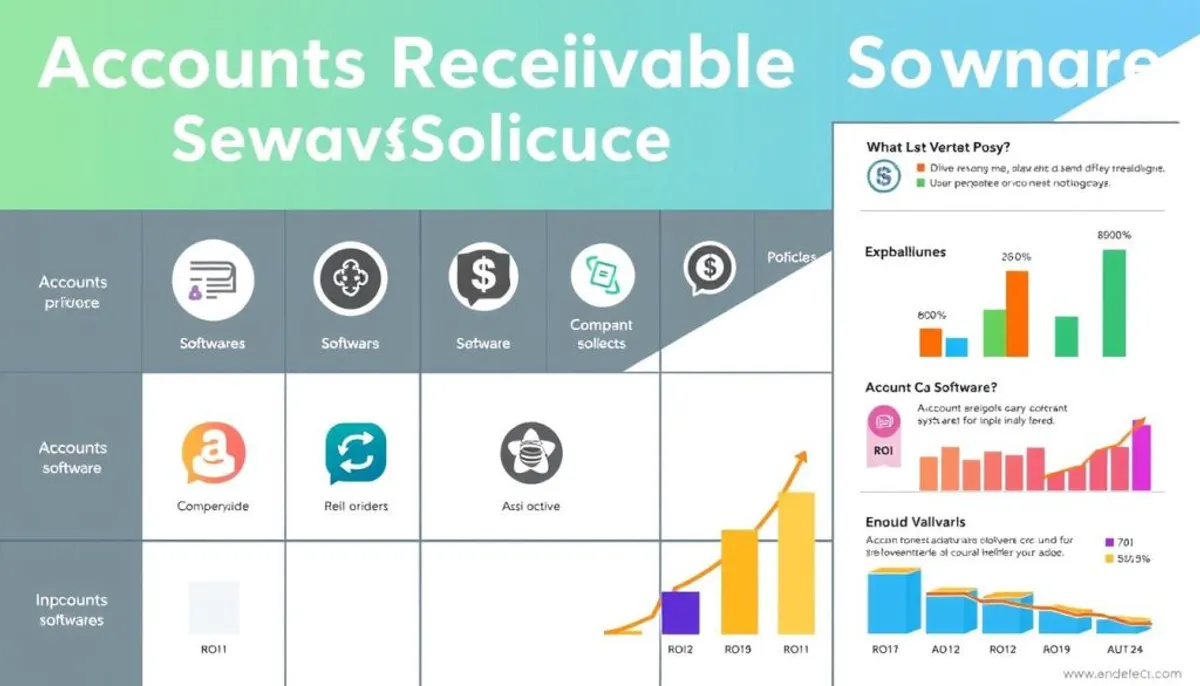Managing accounts receivable can significantly impact a business’s success. The right software can streamline financial processes and enhance cash flow. Let’s explore how accounts receivable software can transform your business operations.
Accounts receivable software is a vital part of modern financial software suites. It tracks invoices, automates payment reminders, and offers insights into financial health. With the right solution, you can eliminate manual data entry and expedite payments.

The market presents a variety of options, from comprehensive accounting platforms to specialized AR automation tools. QuickBooks Online, Xero, and FreshBooks cater to different business sizes and needs. These solutions often feature promotional offers, aiding small businesses in their initial steps.
For example, QuickBooks Online starts at $35 monthly, with a 70% discount for the first three months. Xero begins at $20 monthly, offering a 95% discount for the initial quarter. FreshBooks starts at $19 monthly, with a 75% discount for the first three months.
Accounts receivable software has revolutionized financial management for businesses. It offers a comprehensive suite of tools for invoicing, payment tracking, and reporting. This digital AR management solution simplifies these tasks, enhancing operational efficiency.
AR automation software transforms traditional accounts receivable processes into digital workflows. It automates manual tasks, reducing errors and saving staff time. This software enables businesses to generate invoices, process payments, send reminders, and reconcile accounts with ease.
The fundamental attributes of AR automation software include:
Digital AR management brings significant advantages:
By adopting AR automation, companies can redirect their focus to strategic initiatives. This shift drives growth and efficiency in their financial operations.
Modern enterprises require advanced invoicing software to optimize their accounts receivable operations. The ideal billing software minimizes manual errors and enhances cash flow. Let’s examine the critical attributes that make AR solutions crucial for contemporary organizations.
Automated invoicing revolutionizes AR management. It enables businesses to create and dispatch invoices swiftly, shortening the interval from service completion to payment. Adopting paperless billing not only conserves resources but also accelerates the billing cycle.
Effective collections software incorporates automated payment reminders. These timely alerts can significantly lower late payments and boost cash flow. Real-time reporting empowers businesses with immediate insights into their receivables status, facilitating more informed decision-making.
The premier AR solutions offer seamless integration with other financial systems. This ensures data coherence across platforms, maximizing operational efficiency. By automating intricate billing scenarios, businesses can diminish errors and elevate customer satisfaction.
In conclusion, modern AR software must integrate automation, intelligence, and integration to offer a comprehensive solution for businesses of all scales. The appropriate tools can transform accounts receivable from a time-consuming chore into a strategic asset for expansion.
Businesses aiming for efficient accounts receivable management opt for all-in-one solutions. These platforms merge AR capabilities with comprehensive accounting functionalities. This integration streamlines financial operations for businesses of all sizes.
QuickBooks Online emerges as a leading accounting software, renowned for its robust AR features. It integrates seamlessly with other systems, earning the admiration of accountants. The platform automates tasks such as invoicing, payment reminders, and payment matching. This automation significantly reduces manual effort, by up to 50%.
Xero offers a comprehensive ERP software solution, starting at just $1.40 per month. It provides unlimited users across all plans and a customizable dashboard. Xero’s AR automation capabilities include paperless billing and integrated payment reminders. These features aim to enhance cash flow efficiency and minimize late payments.
FreshBooks is designed for freelancers and small businesses, offering intuitive invoicing and mobile capabilities. Priced from $10 per month when billed annually, it provides an affordable entry point for AR automation. FreshBooks stands out for its user-friendliness, making it an excellent choice for those new to financial management tools.
These all-in-one solutions vary in AR automation capabilities, from basic invoicing to advanced payment processing. When selecting a platform, consider integration capabilities, usability ratings, and the potential for improved cash flow efficiency relative to software costs.

Specialized AR software delivers targeted solutions for managing receivables. These platforms enhance accounts receivable automation, thus boosting efficiency and cash flow. For example, Invoiced offers advanced tools for collections and customer management. It automates accounts payable and receivable workflows, ensuring security against invoice fraud.
Bill.com distinguishes itself by offering comprehensive receivables and payables management. This all-in-one accounting software simplifies complex processes for small and medium-sized businesses. It automates financial operations, including spend and expense management.
These specialized AR automation platforms often integrate with popular accounting software. This flexibility allows businesses to enhance their AR processes without overhauling their entire financial system. Let’s examine some key benefits:
Gaviti’s automated AR management platform customizes workflows, email templates, and reports. It has shown to increase cash flow by up to 50% and reduce days sales outstanding by 30%. These improvements stem from streamlining processes from invoice distribution to cash application.
By adopting specialized AR software, businesses can significantly improve their financial operations. The automation leads to faster payments, improved credit management, and enhanced customer experiences. It’s a wise investment for companies aiming to optimize their accounts receivable processes.
ti3 emerges as a leading-edge SaaS platform for accounts receivable management. It addresses the hurdles of overdue payments with a novel approach to AR automation.
ti3 employs advanced technology for sending timely, tailored payment reminders. This innovation minimizes the need for manual follow-ups, freeing businesses to concentrate on their core operations. The system adjusts reminder frequencies according to client payment history, thus enhancing its efficacy.
The platform automates collection workflows, prioritizing accounts and escalating issues as necessary. It also offers real-time insights into collection progress. This automation significantly reduces costs and increases efficiency compared to traditional methods.
ti3 distinguishes itself by prioritizing positive client relationships. It provides customizable communication templates and tone settings to ensure a friendly yet professional interaction. The platform’s analytics enable early identification of at-risk accounts, facilitating proactive measures to safeguard valuable business relationships.
ti3 integrates automated reminders, streamlined collections, and relationship-centric features to offer a comprehensive AR management solution. This SaaS platform enables businesses to enhance cash flow while fostering client connections. It achieves a balance between operational efficiency and customer satisfaction.
Large organizations with complex accounts receivable needs can benefit from robust enterprise AR solutions. These platforms offer advanced features to streamline high-volume transactions and improve financial processes.
HighRadius provides AI-driven finance solutions that revolutionize AR management. Their platform boasts automated remittance aggregation and high cash application automation rates. By leveraging artificial intelligence, HighRadius can reduce manual errors by up to 90% and accelerate invoice processing by 70%.
BlackLine offers comprehensive financial close and accounts receivable automation. Their solution enhances visibility into AR processes, potentially reducing overdue accounts by 20%. BlackLine’s platform can also improve cash flow forecasting accuracy by over 80% through advanced predictive analytics.
SAP integration allows for seamless incorporation of AR automation into existing enterprise resource planning systems. This integration can lead to a 25% improvement in cash flow and a 30% reduction in administrative costs. SAP S/4HANA features sophisticated credit management tools that assess customer credit risk in real-time, further enhancing AR efficiency.
These enterprise AR solutions cater to organizations dealing with high transaction volumes and complex AR needs. By implementing these advanced platforms, businesses can significantly improve their financial operations and decision-making processes.
Small businesses face the challenge of finding affordable yet effective accounts receivable solutions. Fortunately, there are numerous small business AR software options tailored to meet the financial needs of SMBs. These platforms deliver essential features without straining the budget.
QuickBooks Online stands out as a preferred choice for small businesses, offering AR functionality starting at $35 per month. Xero also competes in the SMB financial solutions market, with plans beginning at $15 monthly. For freelancers and micro-enterprises, FreshBooks presents a viable option, with pricing from $19 per month.
Let’s compare some top small business AR software options:
These SMB financial solutions strike a balance between functionality and affordability. They streamline AR processes, enhance cash flow, and save time for small business owners. When selecting small business AR software, it’s crucial to consider your specific needs, budget, and growth plans to find the most suitable option.
When selecting AR software, businesses must assess costs against potential returns. AR software pricing varies significantly, influenced by the features and scale of operations. We will examine the key factors affecting overall expense and value.
AR software pricing models span from simple monthly subscriptions to complex enterprise plans. Small businesses might choose basic packages starting at $25 per month. In contrast, larger corporations may invest in customized solutions costing $75,000 or more annually. The appropriate choice hinges on your company’s size and specific needs.
Implementation costs extend beyond the software’s price. They encompass setup fees, staff training, and system integrations. Vendor solutions typically have lower initial costs, averaging $3,000. In contrast, in-house solutions can be significantly more expensive, ranging from $500,000 to $2 million upfront.

The ROI of AR automation can be substantial. Companies report up to 390% ROI after implementation. Benefits include faster invoice cycles, improved cash flow, and reduced errors. Automated solutions can decrease past-due receivables by 25-75% and enhance A/R team productivity threefold.
Businesses should meticulously evaluate their specific needs, transaction volumes, and growth plans to determine the most cost-effective AR solution. While upfront costs may seem daunting, the long-term benefits often outweigh the initial investment.
AR software integration is pivotal for enhancing efficiency. Modern solutions effortlessly link with accounting, CRM, and ERP systems. Retail businesses, in particular, must integrate with point-of-sale systems. This integration ensures data flows smoothly, minimizing manual input and errors.
System requirements differ across AR platforms. Cloud-based options demand only a web browser and internet access. On-premises solutions, by contrast, necessitate specific hardware and software setups. It’s crucial to match your AR software with your current technology and future ambitions.
Strong integration capabilities yield substantial advantages. For instance, full AR automation can slash invoicing costs by more than 70%. It also facilitates real-time data access throughout the order-to-cash cycle, enhancing decision-making and cash flow management.
By meticulously evaluating integration capabilities and system requirements, businesses can choose an AR solution that optimizes operations and boosts financial performance.
AR software security is paramount for enterprises handling financial data. Modern accounts receivable solutions implement comprehensive protection measures. These ensure the safeguarding of sensitive information and adherence to regulatory standards.
Top-tier AR software employs cutting-edge encryption methods to safeguard financial data. Access controls are implemented to restrict user permissions, minimizing the risk of unauthorized data access. Regular security updates address vulnerabilities, fortifying systems against emerging threats.
AR software must adhere to stringent compliance standards. PCI DSS ensures secure payment processing, while GDPR safeguards customer data privacy. SOC reporting and ISO certifications underscore a commitment to security excellence. It is imperative for businesses to confirm that their chosen AR solution complies with industry-specific regulations.
Comprehensive audit trails are essential for maintaining transparency in financial operations. AR software with advanced audit capabilities tracks all system activities. This includes user actions, data modifications, and financial transactions. Such features support internal controls and streamline external audits, boosting overall financial accountability.
By focusing on AR software security, compliance, and audit trails, businesses can safeguard their financial data. They meet regulatory demands and maintain trust with customers and stakeholders.
For businesses aiming to optimize their accounts receivable automation, robust AR software support and comprehensive training resources are essential. Leading providers offer extensive support through various channels, including phone, email, and chat. This ensures prompt issue resolution and seamless AR software integration.
Comprehensive training resources typically encompass:
Some AR software companies further enhance their offerings by assigning dedicated success managers. These professionals assist in the implementation process and provide continuous support. They ensure the software’s features are utilized to their fullest potential.
The benefits of adequate training and support are substantial:
By investing in the right AR software support and training, businesses can significantly streamline their accounts receivable processes. This leads to enhanced financial management and increased operational efficiency. Such investments yield tangible benefits, including more precise progress billing and improved project management capabilities.
Choosing the appropriate AR software is vital for optimizing financial processes in today’s business environment. With midsize organizations projected to utilize over 112 SaaS applications by 2024, the need for an efficient AR solution is paramount. The influence of AR software on a company’s financial health is profound.
AR automation significantly enhances cash flow and decision-making capabilities. For example, companies employing automated billing systems experience a 25% reduction in late payments. This efficiency gain also benefits the workforce, automating data entry by up to 70% and freeing up to 50% of accounting staff time for strategic activities.
When selecting AR software, businesses must assess their unique requirements, transaction volumes, and current systems. Cloud-connected accounting systems can enhance data accessibility and collaboration by 40% across departments. Offering multiple electronic payment options and leveraging AI-based automation tools can notably improve accounts receivable turnover ratio and decrease days sales outstanding.
In summary, the correct AR software can revolutionize financial operations, leading to enhanced efficiency, precision, and customer satisfaction. As technology advances, regularly reassessing AR solutions is crucial for businesses to maintain a competitive edge in financial process optimization.